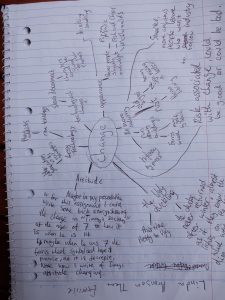Aronson writes “films based on strongly felt themes can be clumsily structured, cliched, people with stereotypes and prone to preachiness”. Aronson is stating that when a theme is too significant in the mind of the writer, the final product can be heavy handed. She suggests that themes are best presented implicitly.
This got me thinking of themes in my world, the main one I came up with is the theme of Progression and Tradition.
Progression Vs Tradition
To begin to explore this theme I must understand the meaning of culture, Google defines Culture as: The ideas, customs, and social behaviour of a particular people or society.
A custom in my culture would be drinking (alcohol), if you don’t drink you’re behaviour (not drinking) isn’t accepted, you are the odd one out.
Social Behaviour: Everything must be done in order to serve and honour the idea of their derelict community. Independent thought is not valued, however acting in a group, following everyone else in the town and obeying their customs is. In the town people litter and spit, this is acceptable social behaviour, however in our own society it isn’t.
Ideas: Any ideas one has consistently links back to the group and doing whats right for the group.
Because the culture hasn’t changed in years (since the industry stopped) people just become set in their ways, which only become more grounded and stable as time goes by. If this world did progress and not stand still, the values I previously described would be replaced by ones cultivated from broader civilisation (the outside world) which would be more refined and make my world more liveable.
This theme of progression vs tradition can be applied to my protagonist because he has the choice to go back home (to his past life) or stay in this rotting town. He could either change or go back home.
The brain storming below is in regards to the theme ‘Change’
I got some good ideas in regards to how I should depict the people of my world, the first thing I wrote was ‘appearance’ which led me to think that the people of my world will be likely overweight or underweight because they are not eating healthy. This led me to place an abundance of fast food places in my town, like McDonalds, Pizza Hut……
Secondly, something I wrote down after taking a photo of my brainstorming, is the weather, I could use it to symbolise the change in my town, in the past it could be warm, now it is cold.
Lastly, I’d like to show the attitude of the civilians through a metaphor of “Timmy” when Timmy was 7 he could look up at the Ferris Wheel and feel hopeful, now Timmy could be fourteen, out of school and not look up once. I could use this metaphor to describe how much world has changed into what it now is.






